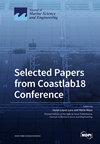Circulation and Stratification Changes in a Hypersaline Estuary Due to Mean Sea Level Rise
IF 2.8
3区 地球科学
Q1 ENGINEERING, MARINE
引用次数: 0
Abstract
Hypersaline Hamelin Pool, with mean salinity >65, is located in Shark Bay, Western Australia. The high salinity has reduced its biodiversity, but it is home to a diverse assemblage of modern marine stromatolites. The limited exchange of water between Hamelin Pool and the rest of Shark Bay, due to the presence of the shallow Faure Sill together with high evaporation and low rainfall-runoff have resulted in a hypersaline environment. With climate-change-induced mean sea level rise (MSLR), hydrodynamic processes that maintain the hypersaline environment may be affected and are the focus of this paper. Oceanographic observations, together with hydrodynamic model results, were used to examine the hydrodynamic processes under present and future MSLR scenarios. A large attenuation in the tidal range, changes in the tidal characteristics, and current speeds together with a strong salinity gradient were observed across the Faure Sill under present-day conditions. Under an MSLR scenario of 1 m, the tidal amplitude decreased by up to 10% to the north, whilst to the south, the tidal range increased by up to 15%. Regions of strong vertical stratification were present on both sides of the Faure Sill. The simulations indicated that, under MSLR scenarios, these regions expanded in area and exhibited higher levels of vertical stratification. The salt flux across the Faure Sill was maintained as a diffusive process under MSLR scenarios.平均海平面上升导致高盐度河口的环流和分层变化
哈梅林池(Hamelin Pool)位于西澳大利亚的鲨鱼湾,平均盐度大于 65。高盐度降低了它的生物多样性,但这里却是现代海洋叠层石多样性的家园。哈梅林池与鲨鱼湾其他地方之间的水交换有限,这是由于浅海福尔山丘的存在,再加上蒸发量大和降雨径流量小,造成了高盐度环境。随着气候变化引起的平均海平面上升(MSLR),维持高盐环境的水动力过程可能会受到影响,这也是本文讨论的重点。本文利用海洋观测数据和水动力模型结果,研究了当前和未来 MSLR 情景下的水动力过程。在目前的条件下,在整个福尔山丘上观测到了潮差的大幅衰减、潮汐特征和流速的变化以及强烈的盐度梯度。在 MSLR 上升 1 米的情况下,北面的潮汐振幅减少了 10%,而南面的潮差则增加了 15%。福尔山丘两侧出现了强烈的垂直分层区域。模拟结果表明,在 MSLR 情景下,这些区域的面积扩大,垂直分层程度更高。在 MSLR 情景下,福尔山谷的盐通量保持为扩散过程。
本文章由计算机程序翻译,如有差异,请以英文原文为准。
求助全文
约1分钟内获得全文
求助全文
来源期刊

Journal of Marine Science and Engineering
Engineering-Ocean Engineering
CiteScore
4.40
自引率
20.70%
发文量
1640
审稿时长
18.09 days
期刊介绍:
Journal of Marine Science and Engineering (JMSE; ISSN 2077-1312) is an international, peer-reviewed open access journal which provides an advanced forum for studies related to marine science and engineering. It publishes reviews, research papers and communications. Our aim is to encourage scientists to publish their experimental and theoretical results in as much detail as possible. There is no restriction on the length of the papers. The full experimental details must be provided so that the results can be reproduced. Electronic files and software regarding the full details of the calculation or experimental procedure, if unable to be published in a normal way, can be deposited as supplementary electronic material.
 求助内容:
求助内容: 应助结果提醒方式:
应助结果提醒方式:


